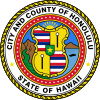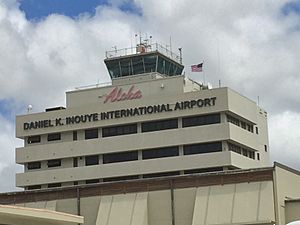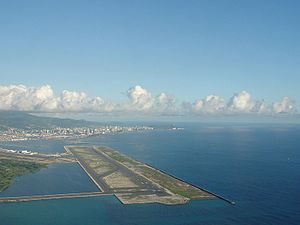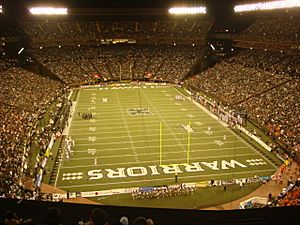Honolulu County, Hawaii facts for kids
Quick facts for kids
Honolulu County
|
|||
|---|---|---|---|
|
Consolidated city-county
|
|||
| City and County of Honolulu Kūlanakauhale a me ke Kalana o Honolulu (Hawaiian) |
|||
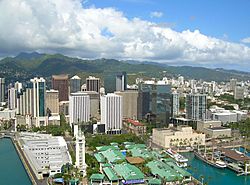
Downtown Honolulu, the city and county urban center
|
|||
|
|||
| Motto(s):
Haʻaheo No ʻO Honolulu
(The Pride of Honolulu) |
|||
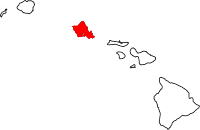
Location in the state of Hawaii (Northwestern Hawaiian Islands not shown)
|
|||
| Country | United States | ||
| State | Hawaii | ||
| Incorporated | April 30, 1907 | ||
| Seat | Honolulu | ||
| Government | |||
| • Type | Mayor–council | ||
| Area | |||
| • Total | 2,128 sq mi (5,510 km2) | ||
| • Land | 601 sq mi (1,560 km2) | ||
| • Water | 1,527 sq mi (3,950 km2) 71.8% | ||
| Population
(2020)
|
|||
| • Total | 1,016,508 | ||
| • Density | 1,691/sq mi (653/km2) | ||
| GDP | |||
| • MSA | $74.422 billion (2022) | ||
| Time zone | UTC−10 (Hawaii–Aleutian) | ||
| Area code(s) | 808 | ||
| Website | honolulu.gov | ||
Honolulu County (Hawaiian: Kalana ʻo Honolulu), officially known as the City and County of Honolulu (formerly Oahu County), is a consolidated city-county in the U.S. state of Hawaii. The city-county includes both Urban Honolulu (the state's capital and largest community) and the rest of the neighborhoods on the island of Oʻahu, as well as several minor outlying islands, including all of the Northwestern Hawaiian Islands (islands beyond Niihau) except Midway Atoll.
The consolidated city-county was established in the city charter adopted in 1907 and accepted by the Legislature of the Territory of Hawaii. As a municipal corporation and jurisdiction it manages aspects of government traditionally exercised by both municipalities and counties in the rest of the United States.
As of the 2020 United States Census, the population was 1,016,508. Because of Hawaii's municipal structure, the United States Census Bureau divides Honolulu County into several census-designated places for statistical purposes.
The mayor of Honolulu County is Rick Blangiardi. The county motto is "Haʻaheo No ʻO Honolulu (Honolulu Pride)". About 70% of the state's population lives in Honolulu County. Only Nevada has a higher percentage of its population living in its most populous county. 43.0% of residents identify as Asian or Asian American, the highest of any U.S. county.
Contents
Geography
According to the U.S. Census Bureau, the county has a total area of 2,128 square miles (5,510 km2), of which 601 square miles (1,560 km2) is land and 1,527 square miles (3,950 km2) (71.8%) is water. However, the majority of this area is the Pacific Ocean that surrounds the islands. At over 1,380 miles (2,220 km) from end to end, it is by a significant margin the widest county in the United States.
Adjacent counties
- Maui County - southeast
- Kauai County - northwest of population center
National protected areas
- James Campbell National Wildlife Refuge
- Oʻahu Forest National Wildlife Refuge
- Papahānaumokuākea Marine National Monument
- Pearl Harbor National Wildlife Refuge
- USS Arizona Memorial
Demographics
| Historical population | |||
|---|---|---|---|
| Census | Pop. | %± | |
| 1900 | 58,504 | — | |
| 1910 | 81,993 | 40.1% | |
| 1920 | 123,496 | 50.6% | |
| 1930 | 202,887 | 64.3% | |
| 1940 | 257,696 | 27.0% | |
| 1950 | 353,020 | 37.0% | |
| 1960 | 500,409 | 41.8% | |
| 1970 | 629,176 | 25.7% | |
| 1980 | 762,565 | 21.2% | |
| 1990 | 836,231 | 9.7% | |
| 2000 | 876,156 | 4.8% | |
| 2010 | 953,207 | 8.8% | |
| 2020 | 1,016,508 | 6.6% | |
| 2023 (est.) | 989,408 | 3.8% | |
| U.S. Decennial Census 1790-1960 1900-1990 1990-2000 2010-2018 |
|||
As of the census of 2010, there were 953,207 people, 311,047 households, and 217,842 families residing in Honolulu County. The population density was 1,461 inhabitants per square mile (564/km2). There were 315,988 housing units at an average density of 527 per square mile (203/km2). The racial makeup of the county was 43.9% Asian, 20.8% white, 9.5% Pacific Islander, 2.0% black or African American, 0.3% Native American, 1.1% from other races, and 22.3% from two or more races. Hispanic or Latino of any race were 9.1% of the population. The largest ancestry groups were:
In the census of 2000, there were 286,450 households, out of which 31.8% had children under the age of 18 living with them, 54.5% were married couples living together, 12.3% had a female householder with no husband present, and 28.2% were non-families. 21.6% of all households were made up of individuals, and 7.0% had someone living alone who was 65 years of age or older. The average household size was 2.95 and the average family size was 3.46.
In the county, the population was spread out, with 23.80% under the age of 18, 10.1% from 18 to 24, 30.6% from 25 to 44, 22.0% from 45 to 64, and 13.4% who were 65 years of age or older. The median age was 36 years. For every 100 females, there were 101.1 males. For every 100 females age 18 and over, there were 99.7 males.
Metropolitan Statistical Area
The United States Office of Management and Budget has designated Honolulu County as the Urban Honolulu, HI Metropolitan Statistical Area. The United States Census Bureau ranked the Urban Honolulu, HI Metropolitan Statistical Area as the 54th most populous metropolitan statistical area and the 61st most populous primary statistical area of the United States as of July 1, 2012.
Economy
Top employers
According to the county's 2022 Annual Comprehensive Financial Report, the top employers in the county are the following:
| # | Employer | # of Employees |
|---|---|---|
| 1 | State of Hawaii | 66,900 |
| 2 | United States Government | 34,700 |
| 3 | City and County of Honolulu | 18,600 |
| 4 | The Queen's Health Systems | 8,426 |
| 5 | Hawaii Pacific Health | 7,119 |
| 6 | Kaiser Foundation Health Plan | 4,382 |
| 7 | Hawaiian Electric Industries Inc. | 3,649 |
| 8 | Kamehameha Schools | 3,357 |
| 9 | Oahu Transit Services Inc. | 2,063 |
| 10 | First Hawaiian Bank | 1,858 |
Other major companies headquartered in Honolulu CDP include Hawaiian Airlines, Aloha Air Cargo, and Bank of Hawaii.
Diplomatic missions
Several countries have diplomatic missions in Honolulu:
 Australia (Consulate General)
Australia (Consulate General) Federated States of Micronesia (Consulate General)
Federated States of Micronesia (Consulate General) Japan (Consulate General)
Japan (Consulate General) Marshall Islands (Consulate General)
Marshall Islands (Consulate General) New Zealand (Consulate General)
New Zealand (Consulate General) Philippines (Consulate General)
Philippines (Consulate General) South Korea (Consulate General)
South Korea (Consulate General) Taiwan (Economic and Cultural Office)
Taiwan (Economic and Cultural Office)
Transportation
Air
Located on the western end of the Honolulu census-designated place, Honolulu International Airport (HNL) is the principal aviation gateway to the state of Hawaii. Numerous airlines fly Pacific-wide to and from Honolulu International Airport. Locally based Hawaiian Airlines also operates flights to destinations within the islands of Hawaii and to major destinations across the Pacific.
Major highways
 H-1
H-1 H-2
H-2 H-3
H-3 H-201
H-201 Route 61
Route 61 Route 63
Route 63 Route 65
Route 65 Route 72
Route 72 Route 80
Route 80 Route 83
Route 83 Route 93
Route 93 Route 95
Route 95 Route 99
Route 99 Route 750
Route 750 Route 801
Route 801 Route 803
Route 803 Route 830
Route 830 Route 930
Route 930
Public transportation
The City and County of Honolulu's Department of Transportation Services oversees two public transportation services, each operated under contract. The fare system is shared between both services and can be paid using the HOLO card.
Bus
TheBus is the transit bus service of the city and county of Honolulu. The system consists of 106 routes, including three express routes and two limited-stop routes.
In 2022, TheBus had a ridership of 38,145,000, or about 126,400 per weekday as of the first quarter of 2023. As of December 2017, TheBus is the nation’s most heavily used public transportation system per capita among major cities. The system is operated in contract with the nonprofit Oahu Transit Services Inc.
Rail
Skyline is a light metro line in the city and county of Honolulu. The first 10.8-mile (17.4 km) phase of the line between East Kapolei (on the ʻEwa Plain) and Aloha Stadium, opened on June 30, 2023. The second phase, connecting to Pearl Harbor and Daniel K. Inouye International Airport before reaching Middle Street, is anticipated to open in the summer of 2025. The final phase, continuing the line across urban Honolulu to Downtown, is due to open in 2031.
Skyline was planned, designed, and constructed by the Honolulu Authority for Rapid Transportation (HART), a semi-autonomous agency of the city-county government. The line is operated in contract with Hitachi Rail, who also built the railcars used on the service.
Education
Colleges and universities
Public institutions in Honolulu County are operated by the University of Hawaiʻi System, which consists of University of Hawaiʻi at Mānoa, Honolulu Community College and Kapiolani Community College in the Honolulu CDP; Leeward Community College in Pearl City; University of Hawaiʻi – West Oʻahu in Kapolei; and Windward Community College in Kaneohe. The University of Hawaiʻi at Mānoa houses the system's main offices.
Private institutions serving the county include Chaminade University and Hawaii Pacific University in the Honolulu CDP and Brigham Young University–Hawaii in Laie CDP.
Primary and secondary schools
The Hawaii Department of Education operates public schools and charter schools in Honolulu County.
Private schools
Honolulu County has one of the highest rates of private school enrollment in the United States. Private schools in Honolulu County include Kamehameha Schools–Kapālama, Punahou School, ʻIolani School, Mid-Pacific Institute, Le Jardin Academy, and Island Pacific Academy. Private religiously-affiliated schools include Maryknoll School, St. Louis School, Hawaii Baptist Academy, Hanalani Schools, Damien Memorial School, Sacred Hearts Academy, and Pacific Buddhist Academy.
Public libraries
The Hawaii State Public Library System operates public libraries. The Hawaii State Library in the Honolulu CDP serves as the main library of the system, while the Library for the Blind and Print Disabled, also in the CDP, serves disabled and blind people. The system operates 22 branch libraries throughout the county.
Arts and culture

Performing arts
Established in 1900, the Hawaii Symphony Orchestra is the oldest US symphony orchestra west of the Rocky Mountains. The Royal Hawaiian Band is even older, established in 1836 by King Kamehameha III and holds the distinction of being the only full-time municipal band in the United States, as well as the only one with a royal legacy. Other ensembles include the Hawaii Opera Theatre. Honolulu is also a center for Hawaiian music. The main music venues include the Neal Blaisdell Center Concert Hall, the Waikiki Shell, and the Hawaii Theatre.
Honolulu also includes several venues for live theater, including Diamond Head Theatre.
Visual arts
There are various institutions supported by the state and private entities for the advancement of the visual arts. The Honolulu Museum of Art is endowed with the largest collection of Asian and Western art in Hawaii. It also has the largest collection of Islamic art, housed at the Shangri La estate. Since the merger of the Honolulu Academy of Arts and The Contemporary Museum, Honolulu (now called the Honolulu Museum of Art Spalding House) in 2011, the museum is also the only contemporary art museum in the state. The contemporary collections are housed at main campus (Spalding House) in Makiki and a multi-level gallery in downtown Honolulu at the First Hawaiian Center. The museum hosts a film and video program dedicated to arthouse and world cinema in the museum's Doris Duke Theatre, named for the academy's historic patroness Doris Duke.
The Capitol Modern Museum is located in downtown Honolulu in No. 1 Capitol District Building and has a collection of art pieces created by local artists as well as traditional Hawaiian art. The museum is administered by the Hawaii State Foundation on Culture and the Arts.
Natural museums
Recognized internationally as the premier cultural institution of Hawaii, the Bishop Museum is the largest of Honolulu's museums. It is endowed with the state's largest collection of natural history specimens and the world's largest collection of Hawaiiana and Pacific culture artifacts. The Honolulu Zoo is the main zoological institution in Hawaii while the Waikiki Aquarium is a working marine biology laboratory. The Waikiki Aquarium is partnered with the University of Hawaiʻi and other universities worldwide. Established for appreciation of botany, Honolulu is home to several gardens: Foster Botanical Garden, Liliuokalani Botanical Garden, Walker Estate, among others.
Sports
Currently, Honolulu has no professional sports teams. Honolulu's Aloha Stadium was a long time host of the NFL's annual Pro Bowl from 1980 to 2016. The NCAA's Hawaii Bowl is played at Aloha Stadium annually. Games are hosted at Les Murakami and Hans L'Orange Park. Fans of spectator sports in Honolulu generally support the football, volleyball, basketball, and baseball programs of the University of Hawaiʻi at Mānoa. High school sporting events, especially football, are especially popular. Venues for spectator sports in Honolulu include:
- Aloha Stadium (American football and soccer)
- Les Murakami Stadium at the University of Hawaiʻi at Mānoa (baseball)
- Stan Sheriff Center at the University of Hawaiʻi at Mānoa (basketball and volleyball)
- Neal Blaisdell Center Arena (basketball)
Honolulu's mild climate lends itself to year-round fitness activities as well. In 2004, Men's Fitness magazine named Honolulu the fittest city in the nation. Honolulu is home to three large road races:
- The Great Aloha Run is held annually on Presidents' Day.
- The Honolulu Marathon, held annually on the second Sunday in December, draws more than 20,000 participants each year, about half to two thirds of them from Japan.
- The Honolulu Triathlon is an Olympic distance triathlon event governed by USA Triathlon. Held annually in May since 2004, there is an absence of a sprint course.
Media
Honolulu County is home to numerous forms media including newspapers, magazines, radio and television.
Communities
Census-designated places
- ʻĀhuimanu
- ʻAiea
- East Honolulu
- East Kapolei
- ʻEwa Beach
- ʻEwa Gentry
- ʻEwa Villages
- Hālawa
- Haleʻiwa
- Hauʻula
- Helemano
- Heʻeia
- Hickam Housing
- Honolulu
- Iroquois Point
- Kaʻaʻawa
- Kahaluʻu
- Kahuku
- Kailua
- Kalaeloa
- Kāneʻohe
- Kaneohe Base (Marine Corps Base Hawaiʻi)
- Kapolei
- Kawela Bay
- Ko Olina
- Lāʻie
- Māʻili
- Mākaha
- Mākaha Valley
- Makakilo
- Maunawili
- Mililani Mauka
- Mililani Town
- Mokulēʻia
- Nānākuli
- Ocean Pointe
- Pearl City
- Punaluʻu
- Pūpūkea
- Royal Kunia (formerly Village Park)
- Schofield Barracks
- Wahiawā
- Waiāhole
- Waialua
- Waiʻanae
- Waikāne
- Waikele
- Waimalu
- Waimānalo
- Waimānalo Beach
- Waipahu
- Waipiʻo
- Waipiʻo Acres
- West Loch Estate
- Wheeler Army Airfield
- Whitmore Village
Other places
Sister cities
Honolulu's sister cities are:
 Avarua, Cook Islands, 2024
Avarua, Cook Islands, 2024 Baguio, Philippines, 1991
Baguio, Philippines, 1991 Baku, Azerbaijan, 1998
Baku, Azerbaijan, 1998 Bruyères, France, 1960
Bruyères, France, 1960 Cali, Colombia, 2012
Cali, Colombia, 2012 Candon, Philippines, 2015
Candon, Philippines, 2015 Caracas, Venezuela, 1990
Caracas, Venezuela, 1990 Cebu City, Philippines, 1990
Cebu City, Philippines, 1990 Chengdu, China, 2011
Chengdu, China, 2011 Chigasaki, Japan, 2014
Chigasaki, Japan, 2014 Edogawa, Japan, 2022
Edogawa, Japan, 2022 Fengxian (Shanghai), China, 2012
Fengxian (Shanghai), China, 2012 Funchal, Portugal, 1979
Funchal, Portugal, 1979 Fuzhou, China, 2021
Fuzhou, China, 2021 Haikou, China, 1985
Haikou, China, 1985 Noreña, Spain, 1960
Noreña, Spain, 1960 Hiroshima, Japan, 1959
Hiroshima, Japan, 1959 Huế, Vietnam, 1995
Huế, Vietnam, 1995 Incheon, South Korea, 2003
Incheon, South Korea, 2003 Kaohsiung, Taiwan, 1962
Kaohsiung, Taiwan, 1962 Kyzyl, Russia, 2004
Kyzyl, Russia, 2004 Laoag, Philippines, 1969
Laoag, Philippines, 1969 Majuro, Marshall Islands, 2001
Majuro, Marshall Islands, 2001 Mandaluyong, Philippines, 2005
Mandaluyong, Philippines, 2005 Manila, Philippines, 1980
Manila, Philippines, 1980 Mombasa, Kenya, 2000
Mombasa, Kenya, 2000 Mumbai, India, 1970
Mumbai, India, 1970 Nagaoka, Japan, 2012
Nagaoka, Japan, 2012 Naha, Japan, 1960
Naha, Japan, 1960 Qinhuangdao, China, 2010
Qinhuangdao, China, 2010 Rabat, Morocco, 2007
Rabat, Morocco, 2007 Saiki, Japan, 2003
Saiki, Japan, 2003 San Juan, Puerto Rico, 1985
San Juan, Puerto Rico, 1985 Seoul, South Korea, 1973
Seoul, South Korea, 1973 Shibuya, Japan, 2024
Shibuya, Japan, 2024 Sintra, Portugal, 1998
Sintra, Portugal, 1998 Uwajima, Japan, 2004
Uwajima, Japan, 2004 Vigan, Philippines, 2003
Vigan, Philippines, 2003 Zhangzhou, China, 2012
Zhangzhou, China, 2012 Zhongshan, China, 1997
Zhongshan, China, 1997
See also
 In Spanish: Condado de Honolulu para niños
In Spanish: Condado de Honolulu para niños



